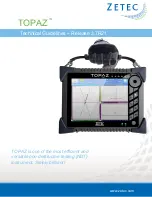
5
Therefore, the CobraNet™ technology used in a
RAVE system employs a regulated, deterministic
system of packet timing to ensure consistent and
reliable transmission without dropouts or glitches.
The RAVE devices on a common network will auto-
matically negotiate the time slots among them-
selves. For efficiency, the sample data from eight
audio channels are grouped together in each packet.
RAVE units will synchronize themselves over the
network, and they have BNC connectors on the rear
panels for sending sync signals. This allows them to
synchronize external digital audio equipment to the
RAVE network.
HOW IT WORKS
Ethernet networks are most often used for computer systems; a typical application would be in an office with
servers, workstations, and shared printers. These devices use the Ethernet medium in an unregulated, non-
deterministic way. This means that they transmit data messages (called “packets”) only when necessary, and
the length of the messages may vary depending on the sending device and on the type and amount of data being
sent. When it has a message to send on the network, a device, or node, waits until there is no traffic, then sends
it. If two or more nodes try to send messages at the same time, a collision occurs; each node then waits a random
length of time before trying again. In this type of application, reasonable latency (the length of time from when
the transmitting node has a message ready to send, to when the receiving node actually receives it) is not a
problem, since a second or two delay in the
transmission of a print job or an e-mail mes-
sage won’t have any noticeable effect.
Audio signals (especially multi-channel), how-
ever, generally can’t tolerate a delay of even
a significant fraction of a second, or even
worse, a varying, unpredictable delay. This
would cause glitches, dropouts, noise, and
other nasty and undesirable artifacts in the
final audio signal.
Internal block diagram of a RAVE unit; chief difference among the different models is the
audio I/O (below)
RAVE 80: 8 AES3 outs
RAVE 81: 8 AES3 ins
RAVE 88: 4 AES3 ins + 4
AES3 outs
RAVE 160: 16 analog outs
RAVE 161: 16 analog ins
RAVE 188: 8 analog ins + 8
analog outs
Summary of Contents for RAVE 160
Page 27: ...26...







































